
Pyropia perforata
Purple Laver
17 June 2022
Kye Bay, Strait of Georgia, B.C., Canada.
Tide: 0.3 feet at 14:41 PDT (measured at Little River Tidal Station)
Conditions: Sunny, wind NNE 10 to 15 km/hour, sea rippled (choppy offshore), humidity 70%, 15˚C.
Moon: Waning Gibbous (84.3%, 18 days); Previous Phase, Full Moon, 14 June 2022 at 4:51am PDT: Next Phase, Third Quarter, 20 June 2022 at 8:10pm PDT.
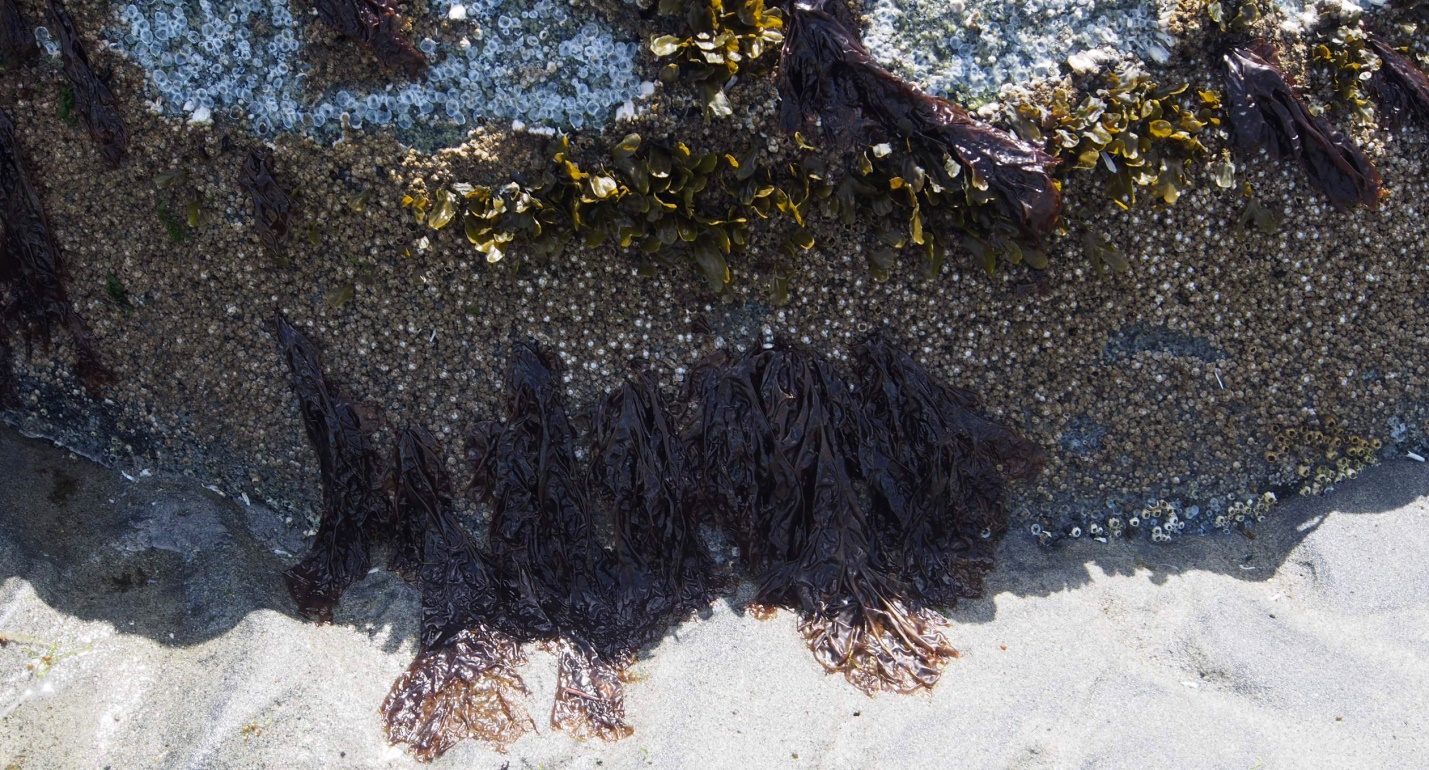
Figure 1: Purple Laver, Pyropia perforata, is pictured here draped from the rock it is growing on. Some are low and half hanging / half flattened on the sand, and others are higher up with the Fucus. The white barnacle ‘footprints’ above the ‘Fucus line’ are all that is left after a killing heat dome of the previous summer which harmed many intertidal organisms. The Purple Laver is still quite moist and ‘colored’ on this shaded side of the boulder. Kye Bay, Strait of Georgia, B.C., Canada. June 17, 2022. Photo ID: 27234 ©Seaweedwhisperings.com
Person 1:
Dark, beautiful purple, especially when submerged or freshly exposed at the falling tide.
“Floats” gracefully when submerged, but “splots” to the substrate when exposed on flat ground.
When exposed on boulders, it hangs limply, totally at the mercy of gravity.
Relatively unattractive when out of water for long. Sometimes forms extensive ‘yucky’ mats that can be slippery to walk on.
So far, my interactions are simply descriptive, with no particular insights or deep connection.
How to survive out of water?
Flatten to the ground to reduce desiccation.
Surrender to desiccation, knowing that life-giving sea water will return soon and all will be good again. Optimist? Confident of the future?
“Join hands” with others to form a desiccation-resistant mass. Cooperative?
The blades have holes (most are circular) hence the species name, ‘perforata’.
Why the holes? Passageways for communication?
Needs only the smallest pebble to support its thallus. Likely gets bounced around the ocean floor. Is this fun? Or just a coping mechanism?
Low down in the intertidal, it can grow but doesn’t proliferate. Perhaps not a good competitor. But higher up, in pebbly substrates that dry out with the receding tide, it can do very well, and perhaps dominate.
Often appears roundish in form with irregular lobes at the edges, reminds me somewhat of a lion’s-mane jellyfish.
Seems OK with its lot in life. Drying out and rehydrating on a daily basis is just the normal routine.
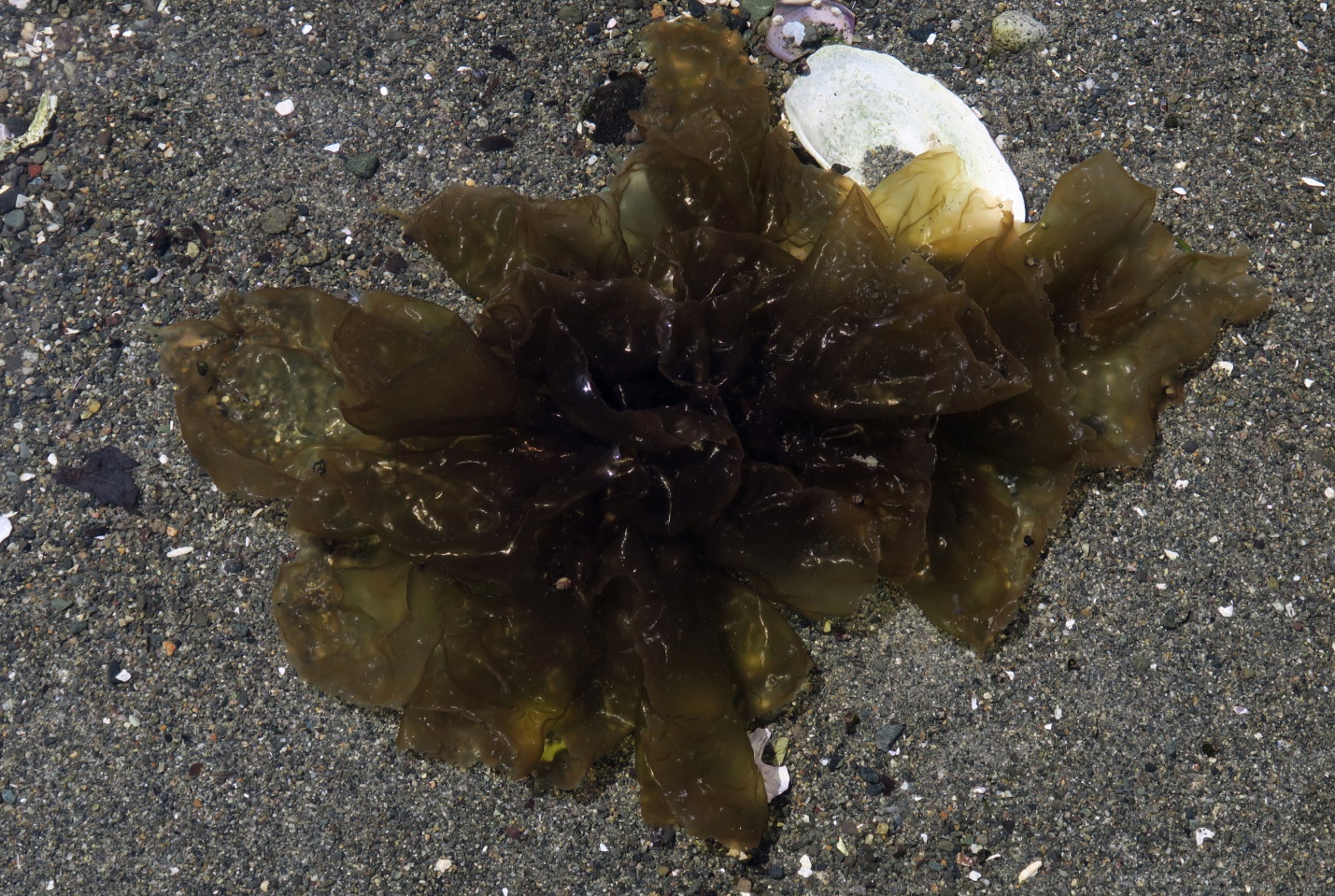
Figure 2: Until we positively identified this species, the tiny sparkles here were a distinguishing feature for this often rose-brown or dull purple seaweed. Without the sparkles, a form of iridescence, this alga could look as if it was dying, so faded in color it appears in comparison to other seaweeds living nearby. Little Qualicum River Estuary, Strait of Georgia, B.C., Canada. July 5, 2020. Photo ID: 27235 ©Seaweedwhisperings.com
Person 2:
A billowy, generously rounded shaped laver, yes, thin and swishy like lavers can be AND you manage to be distinctive in a notable way.
It’s not your size.
And not really your shape.
It is your color.
Your common name promises more purple than you typically deliver. In fact you are often a faded purple-tinged beige/brown.
It’s a color that stands out because of the ‘lack of’ color to it.
Like sepia-toned prints before the age of color photography. The sepia tone has more ‘life’ to it than black and white alone, but it is far from vibrant. Sepia tone is a pale wash of one color over the black and white. Its paleness looks to me almost like the “memory of” a color, the suggestion of color, but without providing actual details.
The other thing that distinguishes you is that when wet you glisten with countless tiny sparkles. You reflect sunlight in this way. These ‘sparkles’ are a key thing I look for to be sure that you are indeed Pyropia perforata. And while the presence of these sparkles of light is distinctive, it is like the sepia tone theme, not overt or flashy or loudly displaying something. No, the sparkles are there to be seen, but only for those who care to look a bit more closely at a drably purple shaped mop of algae floating in shallow tide pools.
As for the ‘perforata’ aspect, this too is not obvious. You have to look, but then indeed you’ll find that the blades of this seaweed are perforated with randomly spaced ‘holes’. The holes aren’t numerous, but maybe they give your generously rounded and lobed blades the ability to both have the ‘sail’ with which to ‘float’ and ‘lift’ with water movement, AND they also to provide an outlet, a flow, so that the lift hopefully rarely gets to be too much, thereby overpowering you.
Sepia-toned, that’s an old style of photographic printing; old fashioned, even antique.
Is there something about you that enjoys “how things used to be”?
You see value in that, it seems.
And while you yourself are not flashy or leading the way with new trends, you do have that inherent sparkle. Again it’s not a strong light that sparkle, certainly not a showy or pushy one, but a light nonetheless.
To enjoy and appreciate your style of light, another needs to pause a while, be patient until you can find the way to share what you know, what matters to you.
You are aware that others more flashy and vibrant than you are more popular, they draw others to them.
You grow side by side with some of them and quietly, almost reticently, waft in the water with your “color” plainly displayed. And in comparison, you are often judged or labelled – subdued, lifeless, faded, “has been”.
Affixed by your holdfast to rock roughly at your middle, when the tide goes out you drape over yourself in layers, forming a wedge of thin layers of alga all folded and draped atop yourself.
As the time of exposure lengthens, you become more and more desiccated and also rather more and more ‘dead’ and ‘lifeless’ looking. But you endure this “drying” very well – remarkably so.
With a bit of ocean water and especially a welcome high tide, your fluid, sparkly, flexible nature returns. The dry, stretched tight expanse of you is quickly forgotten.
If your holdfast has chosen a pebble beach for anchor point, in the low tide this means you are splayed out on the substrate and fully exposed to drying winds and sunlight.
Where you grow, in the mid-intertidal zone, this drying and then re-immersion happens regularly. You can handle it, the exposed-to-air and shrunken-looking dried-tight phase, but maybe I understand your sparkles now – when immersed again your senses are stimulated and sparkles of delight reveal your pleasure to be moving freely with the sea again.
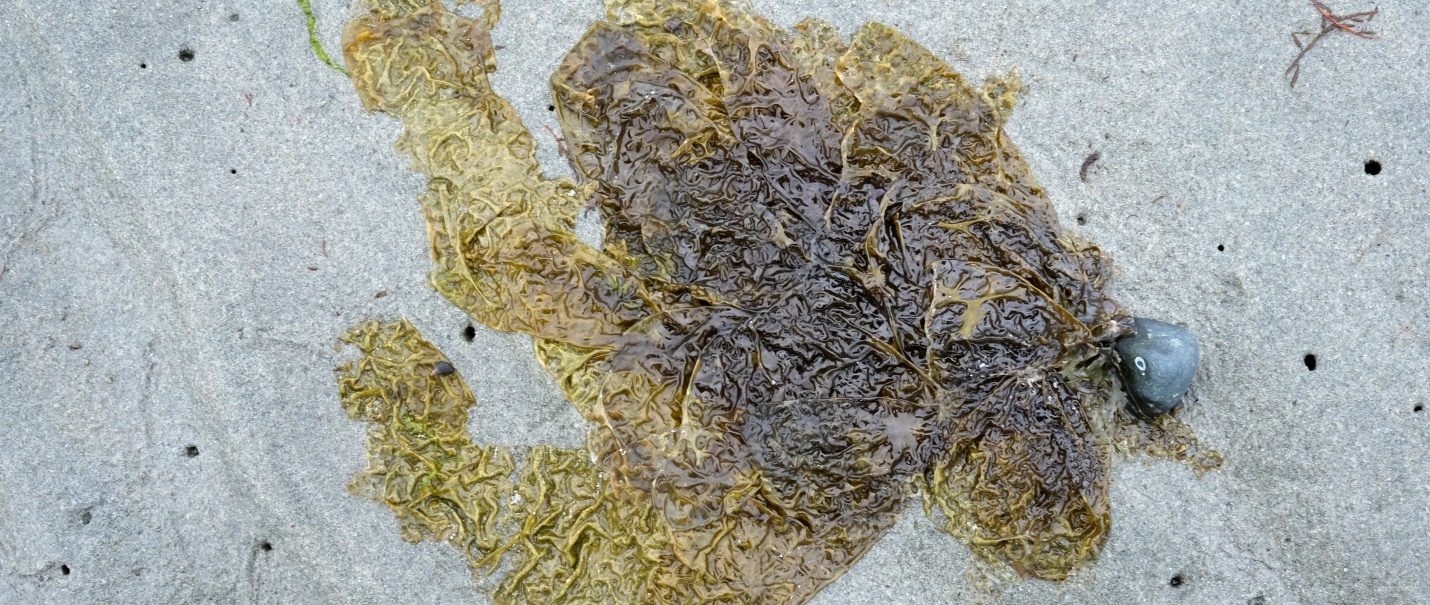
Figure 3: Flattened on the sand, this Purple Laver looks as if it has grown to a size where its pebble holdfast ultimately set ‘sail’ in stormy waters and active surf. Arriving at this new location may not be more advantageous for this seaweed but this is indeed what has resulted. High winds are less common in spring and summer which are the growth times for the bladed form of Purple Laver, so possibly it uncommon that many Pyropia-adorned pebbles are displaced in such a manner. Little Qualicum River Estuary, Strait of Georgia, B.C., Canada. June 15, 2022. Photo ID: 27236 ©Seaweedwhisperings.com
Discussion:
We came to wonder if you keep much of your true character well hidden inside yourself, Pyropia perforata. How and where you grow suggests that you almost want to be overlooked and not paid much attention. I certainly have noted that in comparison to other macro algae that grow nearby, your look, especially when not immersed in seawater, has the quality of “nothing special here” or even a piece of discarded trash or litter that is well worn and dirtied by the elements. We think this must serve you in important ways.
Does hiding from scrutiny and detection give you something of value?
In society, most attention often is directed to those who “show” well; to those who have some outward sign of success and a personal happiness with those same accomplishments. You, Purple Laver, possess little of that quality.
Is there something in your past that has taught you to be reticent in this way?
Has success eluded you or been stolen from you?
Certainly if you have a fondness for / value of old fashioned things (sepia-toned), then you know the passing nature of fashion and popular trends, the impermanence of most anything one can materially possess.
Is that why you are much more comfortable in the past? You can rest there comfortably in the dictates of a known era rather than involve yourself in building and defining the current one?
Or, are you aware that you cannot, and do not choose to, keep up with current cultural trends? Is that somehow beyond your means and outside of your interests and thus is replaced by something already comfortably known to the history books? You may enjoy the company of others who share in this kind of pleasure – collector car shows, period-specific music and dress, activities such as these are where you can shine.
Perhaps Pyropia perforata that is it – you sparkle when you are in touch with the past and you are quite lifeless looking when it comes to the present. The alternation is quite distinct! Is this the routine challenge you face, with each and every tide, relentlessly trying to balance past and present in a way that works for you.
A bit of research on sepia toning in photography reveals that this process was used in the darkroom processing of images to prevent fading and prolong a photograph’s life and archival value. In the 1850’s, when this was first being used, photographs (often portraits) were far more unusual and valuable than they are today. A rather delightful side benefit of the sepia tone process, which imparts a lovely rose-brown tone, is that austere black and white images could be imbued with more warmth, a more pleasing scale of intensity and also greater emotional appeal. The sepia tone process was used well into the 1920’s when new photographic developing methods came into use.
An interesting “of the sea” aspect to this is that sepia tone is derived from cuttlefish ink which contains numerous sulfuric compounds. In developing a print in the darkroom, light-sensitive silver halides of the film are converted to metallic silver. The sepia toner used in this process coverts the metallic silver to a sulfide compound, silver sulfide, which is considerably more stable than metallic silver. Thus sepia tone photographic processing slows fading and deterioration and protects from other environmental degradations; the photographs developed with it last twice as long to those developed without.
Interestingly, Person 1 was reminded of a lion’s mane jelly fish when he observed some of the Purple Laver in situ. Cuttlefish and jelly fish are not closely related taxonomically, but they both are animals of the sea. Does this seaweed, Purple Laver, have some ‘animal’ dreams or aspirations? It’s an odd thought but why not? Quite possibly Pyropia has an admiration for and a curiosity about some of these other life forms that live in the ocean with it. How freeing the power of independent movement must seem to a firmly anchored seaweed. Does Pyropia also understand the challenges of invertebrate life? The defenses needed to survive as an animal such as the stinging cells of the jellyfish and the cloud of purple cuttlefish ink which serves as a chemical deterrence and aids in evasion of predators.
So once again the alternation theme comes up. Possibly Pyropia perforata is billowy, flexible and sparkling when dreaming and aspiring and reminiscing, but then flattened, desiccated and lifeless-looking when attempting to manifest tangible effort in their current form and time. These are some tough extremes to routinely embrace, Purple Laver, and something within your nature is also subtly strong enough to endure and to learn from the constant alternation.
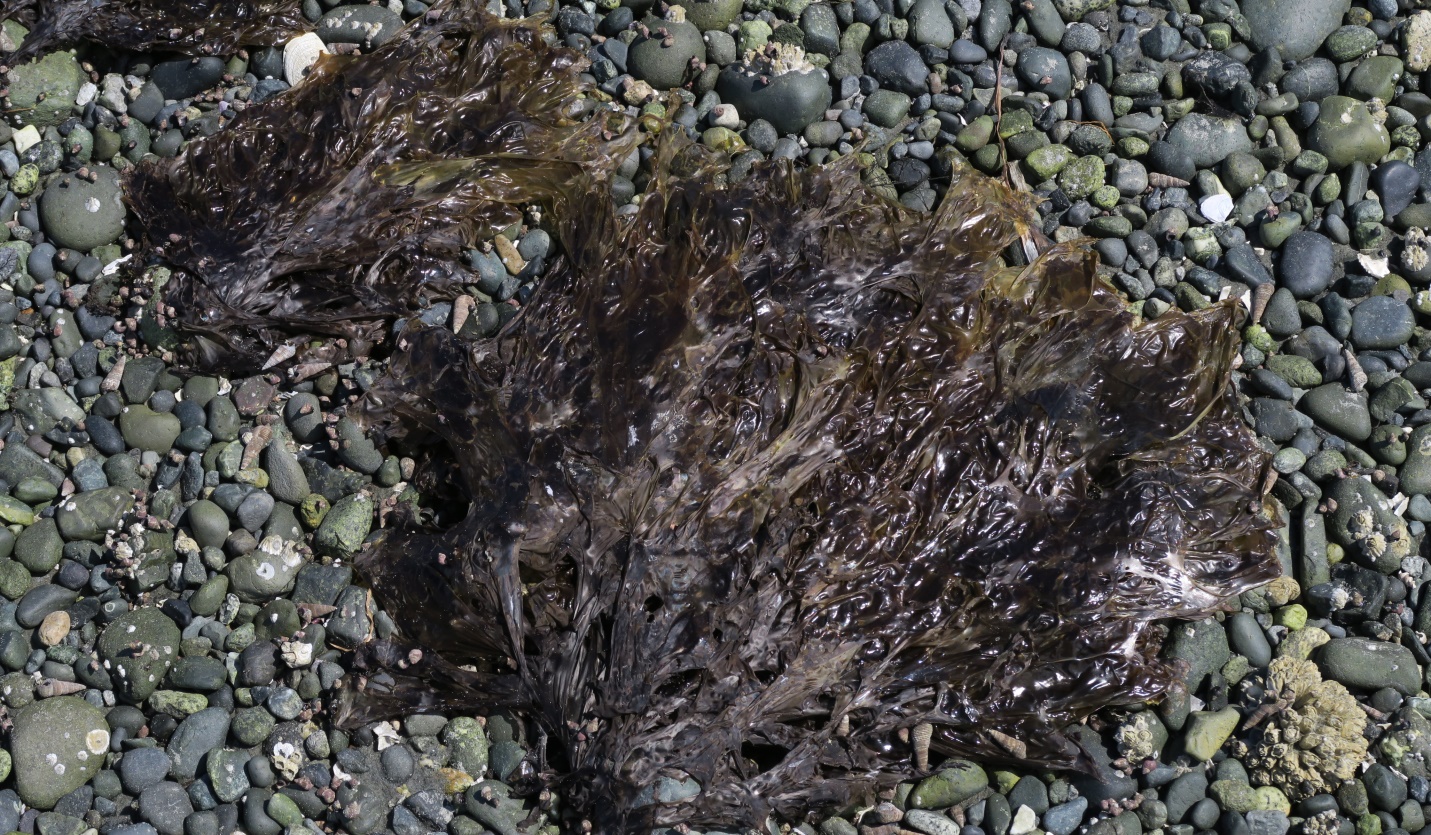
Figure 4: Anchored to their pebble cobbles, these Pyropia perforata are exposed to the sunlight and wind while the tide is out. A regular occurrence for this species and one it is well adapted to, Purple Laver is capable of rehydrating very well and very quickly when the ocean waters return. Little Qualicum River Estuary, Strait of Georgia, B.C., Canada. July 5, 2020. Photo ID: 27237 ©Seaweedwhisperings.com
Biology & Natural History Information:
Description:
Thallus is a purple (sometimes greenish) broadly expanded blade that is only a single cell layer thick but can grow to sizes 30 cm wide and a similar length. Holdfast is small and disc shaped and attaches to rocks, and opportunistically to other algae. The blade margins are ruffled and can be deeply lobed. When exposed to sunlight the blades are iridescent. Growth is diffuse throughout the blade rather than limited to a defined meristem. The thin blades are easily torn when wet, and when exposed at lower tides the blades first become rubbery and then brittle. The bladed form is the gamete producing life stage; the alternate spore producing life stage (called the conchocelis phase) is filamentous, microscopic in size and grows inside the shells of mollusks and barnacles.
Habitat:
This species occurs in the mid intertidal on rock in semi-protected to semi-exposed habitats. It is common and abundant in spring and summer.
North Pacific Distribution:
Its range extends from the Aleutian Islands south to Baja California and includes the Bering Sea, The Sea of Okhotsk and parts of Russia. While common in British Columbia, Canada, it is less common in Alaska.
Remarks:
A favorite grazing meal for limpets, this laver is not favored so much by humans like other species in the genus. Nutritional studies show that the limpets have the right idea, as Pyropia perforata has been shown to be nutritionally dense (4.31 calories per gram of dry weight) and it had the highest caloric content of any seaweed tested.
The origin of the species name, perforata, is from the adjective (Latin), meaning pierced with holes or pores or sprinkled with translucent dots (Stearn 1973).
Classification:
Phylum: Rhodophyta
Class: Bangiophyceae
Order: Bangiales
Family: Bangiaceae
Genus: Pyropia
Species: Pyropia perforata (J.Agardh) S.C.Lindstrom 2011
Former name(s): Porphyra perforata J.Agardh
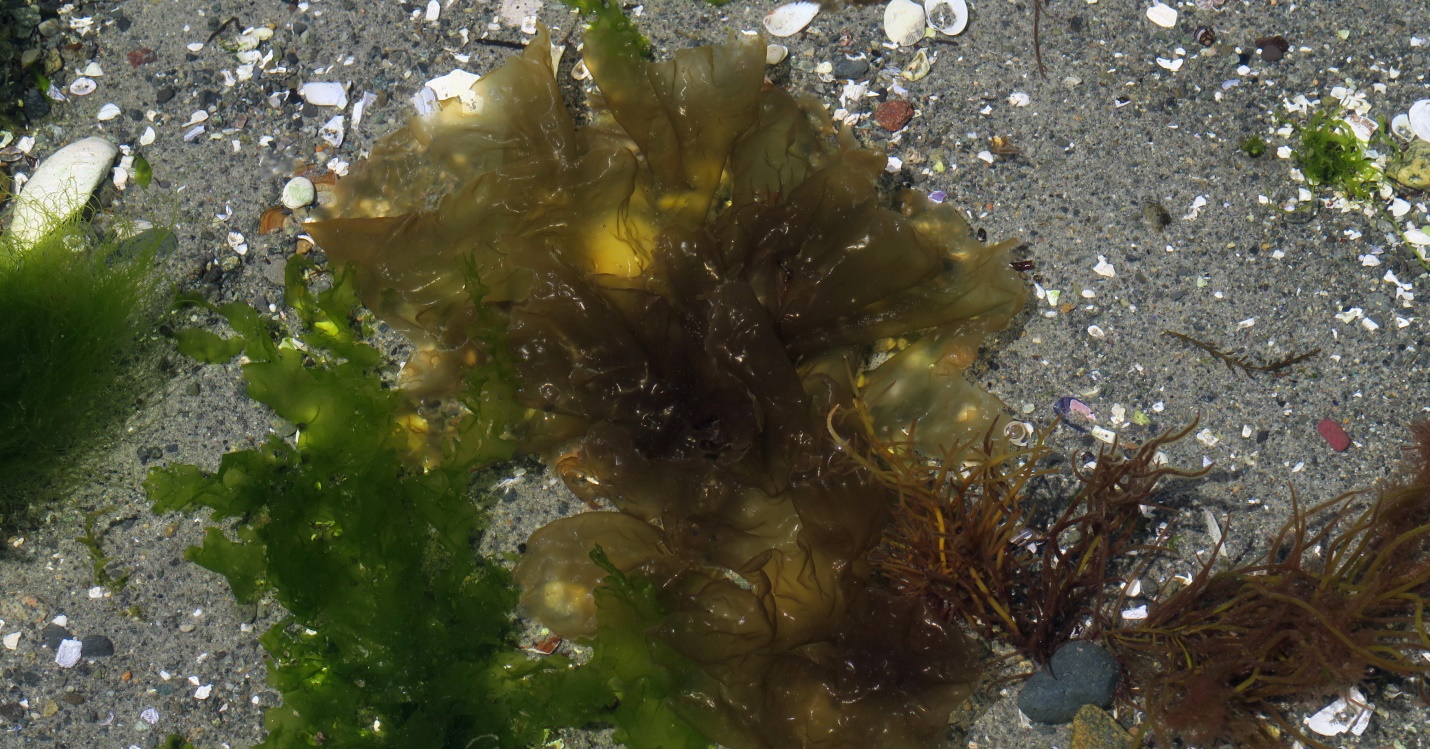
Figure 5: A view of Purple Laver and some of its neighboring macro algae shows the type of coloration that is common. Little Qualicum River Estuary, Strait of Georgia, B.C., Canada. July 5, 2020. Photo ID: 27238 ©Seaweedwhisperings.com
![]()